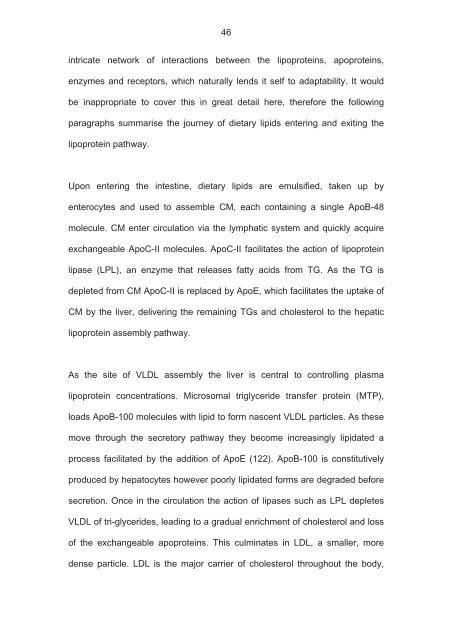The role of scavenger receptor BI in hepatitis - eTheses Repository ...
The role of scavenger receptor BI in hepatitis - eTheses Repository ...
The role of scavenger receptor BI in hepatitis - eTheses Repository ...
Create successful ePaper yourself
Turn your PDF publications into a flip-book with our unique Google optimized e-Paper software.
46<br />
<strong>in</strong>tricate network <strong>of</strong> <strong>in</strong>teractions between the lipoprote<strong>in</strong>s, apoprote<strong>in</strong>s,<br />
enzymes and <strong>receptor</strong>s, which naturally lends it self to adaptability. It would<br />
be <strong>in</strong>appropriate to cover this <strong>in</strong> great detail here, therefore the follow<strong>in</strong>g<br />
paragraphs summarise the journey <strong>of</strong> dietary lipids enter<strong>in</strong>g and exit<strong>in</strong>g the<br />
lipoprote<strong>in</strong> pathway.<br />
Upon enter<strong>in</strong>g the <strong>in</strong>test<strong>in</strong>e, dietary lipids are emulsified, taken up by<br />
enterocytes and used to assemble CM, each conta<strong>in</strong><strong>in</strong>g a s<strong>in</strong>gle ApoB-48<br />
molecule. CM enter circulation via the lymphatic system and quickly acquire<br />
exchangeable ApoC-II molecules. ApoC-II facilitates the action <strong>of</strong> lipoprote<strong>in</strong><br />
lipase (LPL), an enzyme that releases fatty acids from TG. As the TG is<br />
depleted from CM ApoC-II is replaced by ApoE, which facilitates the uptake <strong>of</strong><br />
CM by the liver, deliver<strong>in</strong>g the rema<strong>in</strong><strong>in</strong>g TGs and cholesterol to the hepatic<br />
lipoprote<strong>in</strong> assembly pathway.<br />
As the site <strong>of</strong> VLDL assembly the liver is central to controll<strong>in</strong>g plasma<br />
lipoprote<strong>in</strong> concentrations. Microsomal triglyceride transfer prote<strong>in</strong> (MTP),<br />
loads ApoB-100 molecules with lipid to form nascent VLDL particles. As these<br />
move through the secretory pathway they become <strong>in</strong>creas<strong>in</strong>gly lipidated a<br />
process facilitated by the addition <strong>of</strong> ApoE (122). ApoB-100 is constitutively<br />
produced by hepatocytes however poorly lipidated forms are degraded before<br />
secretion. Once <strong>in</strong> the circulation the action <strong>of</strong> lipases such as LPL depletes<br />
VLDL <strong>of</strong> tri-glycerides, lead<strong>in</strong>g to a gradual enrichment <strong>of</strong> cholesterol and loss<br />
<strong>of</strong> the exchangeable apoprote<strong>in</strong>s. This culm<strong>in</strong>ates <strong>in</strong> LDL, a smaller, more<br />
dense particle. LDL is the major carrier <strong>of</strong> cholesterol throughout the body,

















